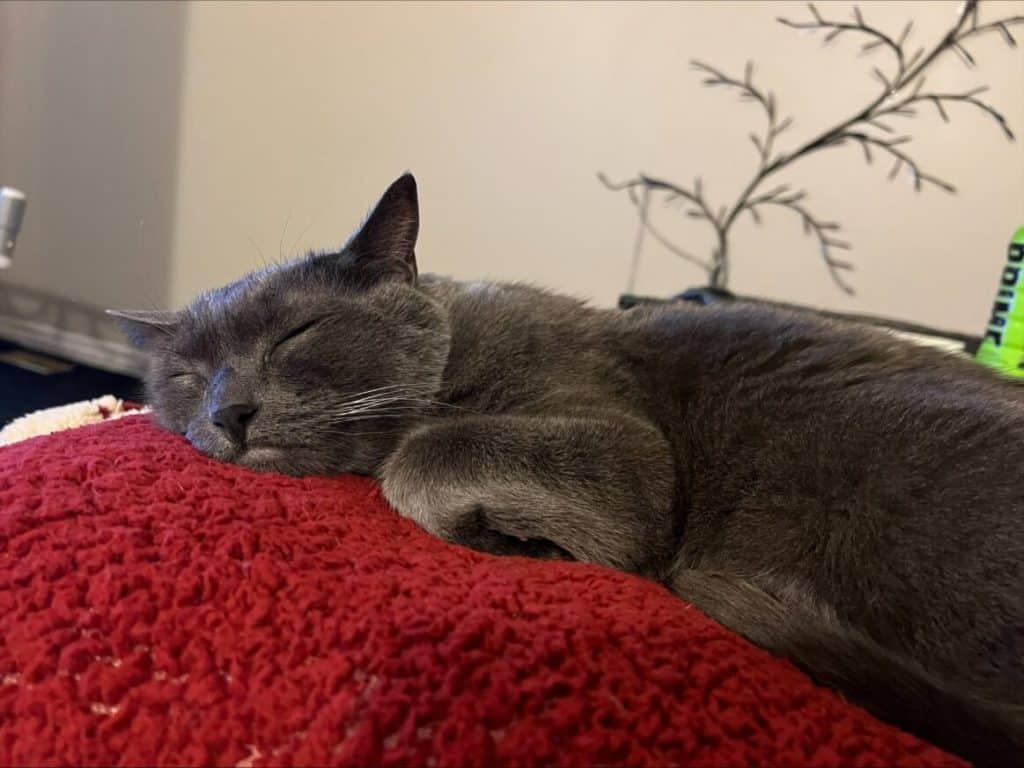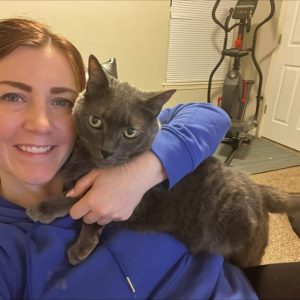Carbon is a ten year old neutered male domestic shorthair cat who recently had a successful fear-free vet visit with Dr. Gottman. Carbon and his owner have struggled with vet visits in the past due to Carbon’s fear, anxiety, and stress.

His owner suspects his fear of the vet started after he was hospitalized for urinary crystals when he was one year old. Although hospitals can do things to mitigate fear during hospitalization, being away from home can be really scary for pets. He started acting aggressively when handled below his ribcage; he would hiss and even try to bite if pushed too far. Once he became fearful, it was difficult to get him to relax again.
Dr. Gottman took note of Carbon’s behavior and recommended Gabapentin. This is a medication commonly used to treat anxiety in cats by helping them relax. Carbon’s owner was unable to “pill” him, so they tried mixing the powder from a capsule of Gabapentin into his food. Unfortunately he was able to detect something different and never got the full dose. Luckily, we also have a liquid form of Gabapentin that can be given orally via syringe. Carbon’s owner decided to try the liquid instead and found that giving the medication went a lot smoother as she was able to give him a little bit at a time until the full dose was administered.

Carbon’s owner said trying to “pill” a cat is as difficult as taking a steak away from a lion. This is probably relatable to many cat (or dog) owners as some pets are skilled at tasting medications and spitting them out. Our staff wants to know when an owner is struggling to give any medication as we can work with them to find a solution. We recommend when attempting to have a cat swallow a pill, hiding it in a meatball of tasty wet pate as they may swallow the whole capsule with the food. (It is important to never “dry pill” a cat; it must always be coated with something and followed with water or a snack to prevent irritation to the throat) If the capsule must be broken open to mix the contents in food, it should be mixed in a enough of high value, smelly food to cover the taste. Pairing the meds with a training session and some treats that do not contain medication can help disguise the pill even more. If you find that giving medications is a struggle, reach out to your vet to brainstorm some solutions.
Most situational anxiety medications are given 2-3 hours prior to a stressful event so the medication can reach peak effect at the vet office. In Carbon’s case, he was seeing Dr. Gottman for his annual wellness exam and a vaccine. He was taking treats and accepting chin scratches. She performed his exam with no problems. She avoided touching his rear end as this locations has previously caused him to act aggressively due to fear, anxiety, and stress. We often look at painful, or triggering, parts of a pet last in order to avoid escalating their fear, anxiety, and stress. When it came time for his vaccine, Dr. Gottman decided to vaccinate in his shoulder instead of his hip to avoid triggering him. He grumbled a bit while eating his treats, but continued to focus on the yummy food. Carbon’s owner was relieved. This was the first time that he hadn’t been outwardly aggressive in 9 years!We recommend when attempting to have a cat swallow a pill, hiding it in a meatball of tasty wet pate and they may swallow the whole capsule with the food. If the capsule must be broken open to mix the contents in food, it should be mixed in a larger volume of high value, smelly food to cover the taste.

Carbon’s owner mentioned that the mild side effects of the Gabapentin were well worth the outcome of a successful wellness visit and vaccine administration. She noted that Carbon was relaxed and seemed “drunk” with slightly altered motor skills; she said he was like a “sleepy toddler that you have to keep an eye on” but that Carbon was back to his normal self in a few hours. It is important to monitor your pet while they are taking a medication that affects their motor skills so they don’t injure themselves. The dosage of an anxiety medication can always be adjusted if the desired effects are not achieved. Vets rely on owners to let them know what they are seeing at home so a dosage can be adjusted.
Wellness visits are important to your pet’s health so a doctor can monitor their physical and emotional health over time. It is also a great opportunity for owners to ask questions and stock up on heartworm and flea/tick prevention. The doctor will listen to your pet’s heart, feel their joints for signs of arthritis, check for ear infections, among other things. Dr. Gottman understands that although Carbon may act aggressively while at the hospital, he isn’t a “mean” or “bad” cat. Fear, anxiety, and stress affects humans and pets and there are many tools that can be used to make pets more comfortable at the vet. Dr. Gottman and Carbon’s owner were able to work together to come up with a plan leading to the best outcome during Carbon’s wellness exam. Our staff is happy knowing that although Rock Bridge Animal Hospital may not be Carbon’s favorite place, he is a healthy kitty at home where he enjoys running the house ahead of his siblings. He is part of a bonded pair and they get up to many shenanigans, particularly with their mice toys. Carbon can also be found sunning himself, with his arms fully extended, dreaming about how he won’t have to see Dr. Gottman again for another six months. But when he does have to visit us, Carbon’s owner is grateful she’s found a solution.
